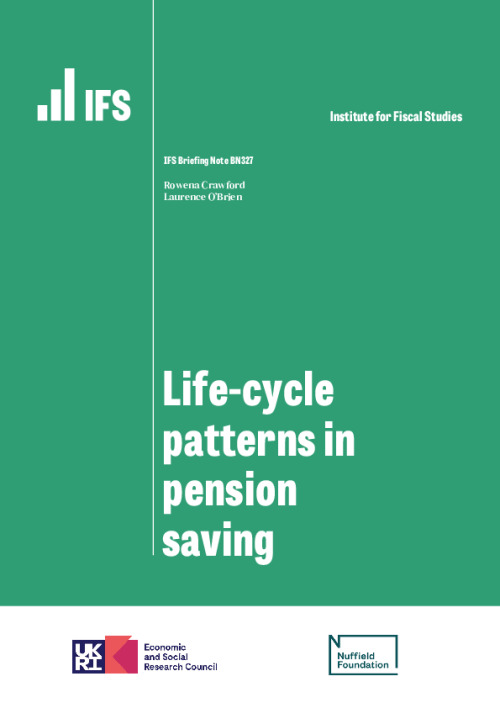Most people need to save privately for retirement if they want to enjoy a comparable standard of living in retirement to that which they have enjoyed during working life. How much to save, and when, is largely up to individuals to decide. While there has been lots of discussion among policymakers, industry and researchers about how much people should save privately for retirement, and whether individuals’ actual savings are adequate, there has been much less focus on when individuals should save, and whether they behave this way in practice.
In an ongoing programme of research, kindly funded by the Nuffield Foundation, we aim to address this evidence gap – examining in detail how pension saving might be expected to change over working life, and how employees and the self-employed behave in practice. In particular, we will analyse how saving rates change with age, with changes in earnings, and with other changes in people’s circumstances.
How might people be expected to behave?
In a related publication, we quantify how one might expect the saving rate to change over working life, given factors such as the arrival and departure of children, changes to earnings, or the ending of student loan repayments (Crawford, O’Brien and Sturrock, 2021). The findings of that work are clear: there are good reasons to expect individuals would dramatically increase pension contributions in later working life, rather than saving a constant proportion of their income every year. But how do people behave in practice?
How do employees behave in practice?
In this briefing note, we present initial evidence on the ‘big picture’ of how employees’ pension saving changed over the course of working life before automatic enrolment started to be rolled out in October 2012. (These patterns will be explored in more detail in the ongoing research programme.) Why is this still of interest, when automatic enrolment is known to have affected pension saving behaviour, substantially increasing the proportion of private-sector employees saving in a pension? Well, many people were saving in a pension before automatic enrolment, and their behaviour – for example, when and why they change their contribution rates – may be unaltered by the introduction of automatic enrolment. It is therefore important to understand this behaviour, in order to project the future retirement resources of these people, and to understand how possible future policy reforms may affect them. If automatic enrolment has altered behaviour, then we need to know how individuals previously acted in order to fully appreciate the effects (intended and otherwise) of automatic enrolment.
In this briefing note, using data from the Annual Survey of Hours and Earnings (ASHE) from 2005 to 2012, we document how average pension contributions to workplace pensions evolve with age – estimating ‘age profiles’ that abstract from differences in levels of pension saving in different years.
Key findings
- Before automatic enrolment was introduced, there was an age profile in defined contribution (DC) pension saving among private-sector employees. However, the increase in average contributions as a share of earnings through working life was small. Across all private-sector employees, including those not saving in a DC pension at a particular point in time, we estimate that mean contributions into DC pensions increase by around 2 percentage points of gross pay between the early 20s and mid-50s.
- Much of this increase in average contributions with age was driven by net movements into saving in a workplace DC pension, particularly among those in their 20s and early 30s. We estimate an increase in the membership rate of DC pensions of 10 percentage points during people’s 20s, but smaller increases in membership rates with age thereafter.
- Average pension contributions among those saving in a DC pension increased steadily but slowly throughout the whole of working life – by around 5 percentage points of gross pay between the early 20s and late-50s. This arises from increases in both average employer and average employee contributions – by around 3 percentage points and 2 percentage points of gross pay, respectively.
- Automatic enrolment has increased private pension membership, particularly among younger individuals. The effect of this will be to have further flattened the age profile of pension saving.
- Comparing the age profile of pension saving as a share of earnings between male and female private-sector employees before automatic enrolment, average pension saving was broadly similar until the mid-30s, but then diverged sharply as average pension contributions continue to increase with age for men but plateau for women. This will have driven a gender pension gap over and above that arising from differences in labour market attachment or average earnings.
- This pattern was driven by differences in the age profiles of pension membership. Before automatic enrolment was introduced, male and female private-sector employees were similarly likely to be saving in a pension until around age 30, but then the proportion saving continued to increase with age for men but not women. The age profiles for average contributions as a percentage of gross pay conditional on being a member of a workplace pension are much more similar (and, in fact, are higher for women than men).
- Automatic enrolment will have changed the nature of the gender pension gap going forwards, by substantially increasing pension membership, and resulting in a difference in pension membership between male and female employees that is more uniform with age. Understanding the drivers of the previous gender pension gap is therefore important for fully assessing the impacts of automatic enrolment, and the channels through which it affects individuals.
While these findings reveal that pension saving as a share of earnings does increase over working life, the picture is more gradual, and saving less concentrated in later life, than a simple economic model might suggest. Automatic enrolment will likely have further flattened age profiles, as it has increased pension membership particularly among younger individuals.
In the remainder of our research programme, we will be exploring in depth the drivers behind the empirical trends presented here – examining what causes individuals to start saving in a pension when they do, when and why people change their pension contributions, and how that correlates with changes in individuals’ employment circumstances or other household characteristics. In particular, we will examine what drove the divergence in the behaviour of male and female employees in their 30s.
These questions are important. While this evidence is based on behaviour before the introduction of automatic enrolment, this is likely to still be informative of how those more ‘active’ savers (who would have been saving in the absence of the reform) continue to save. This is important in order to project the likely retirement resources of these individuals, and to understand better the impact of automatic enrolment and the likely effects of potential new policies to encourage greater retirement saving.











